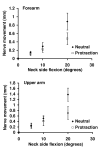Shoulder posture and median nerve sliding
- PMID: 15282032
- PMCID: PMC503391
- DOI: 10.1186/1471-2474-5-23
Shoulder posture and median nerve sliding
Abstract
Background: Patients with upper limb pain often have a slumped sitting position and poor shoulder posture. Pain could be due to poor posture causing mechanical changes (stretch; local pressure) that in turn affect the function of major limb nerves (e.g. median nerve). This study examines (1) whether the individual components of slumped sitting (forward head position, trunk flexion and shoulder protraction) cause median nerve stretch and (2) whether shoulder protraction restricts normal nerve movements.
Methods: Longitudinal nerve movement was measured using frame-by-frame cross-correlation analysis from high frequency ultrasound images during individual components of slumped sitting. The effects of protraction on nerve movement through the shoulder region were investigated by examining nerve movement in the arm in response to contralateral neck side flexion.
Results: Neither moving the head forward or trunk flexion caused significant movement of the median nerve. In contrast, 4.3 mm of movement, adding 0.7% strain, occurred in the forearm during shoulder protraction. A delay in movement at the start of protraction and straightening of the nerve trunk provided evidence of unloading with the shoulder flexed and elbow extended and the scapulothoracic joint in neutral. There was a 60% reduction in nerve movement in the arm during contralateral neck side flexion when the shoulder was protracted compared to scapulothoracic neutral.
Conclusion: Slumped sitting is unlikely to increase nerve strain sufficient to cause changes to nerve function. However, shoulder protraction may place the median nerve at risk of injury, since nerve movement is reduced through the shoulder region when the shoulder is protracted and other joints are moved. Both altered nerve dynamics in response to moving other joints and local changes to blood supply may adversely affect nerve function and increase the risk of developing upper quadrant pain.
Figures






Similar articles
-
Quantitative in vivo studies of median nerve sliding in response to wrist, elbow, shoulder and neck movements.Clin Biomech (Bristol). 2003 Dec;18(10):899-907. doi: 10.1016/s0268-0033(03)00176-1. Clin Biomech (Bristol). 2003. PMID: 14580833
-
Longitudinal sliding of the median nerve in patients with non-specific arm pain.Man Ther. 2008 Dec;13(6):536-43. doi: 10.1016/j.math.2007.07.004. Epub 2007 Oct 2. Man Ther. 2008. PMID: 17913563
-
An in vivo investigation of ulnar nerve sliding during upper limb movements.Clin Biomech (Bristol). 2007 Aug;22(7):774-9. doi: 10.1016/j.clinbiomech.2007.04.004. Epub 2007 May 24. Clin Biomech (Bristol). 2007. PMID: 17531363
-
Fascicular Involvement of the Median Nerve Trunk in the Upper Arm: Manifestation as Anterior Interosseous Nerve Syndrome With Unique Imaging Features.Korean J Radiol. 2024 May;25(5):449-458. doi: 10.3348/kjr.2023.1218. Korean J Radiol. 2024. PMID: 38685735 Free PMC article. Review.
-
A structural relationship model of cervicobrachial region for the treatment of shoulder dysfunction: Evidence-Based clinical reasoning narrative.J Bodyw Mov Ther. 2025 Sep;43:394-406. doi: 10.1016/j.jbmt.2025.04.043. Epub 2025 May 3. J Bodyw Mov Ther. 2025. PMID: 40483153 Review.
Cited by
-
The pattern of tibial nerve excursion with active ankle dorsiflexion is different in older people with diabetes mellitus.Clin Biomech (Bristol). 2012 Nov;27(9):967-71. doi: 10.1016/j.clinbiomech.2012.06.013. Epub 2012 Jul 17. Clin Biomech (Bristol). 2012. PMID: 22809735 Free PMC article.
-
Interaction between Pain, Disability, Mechanosensitivity and Cranio-Cervical Angle in Subjects with Cervicogenic Headache: A Cross-Sectional Study.J Clin Med. 2021 Jan 5;10(1):159. doi: 10.3390/jcm10010159. J Clin Med. 2021. PMID: 33466533 Free PMC article.
-
Prevalence of Lower Back Pain and its Relationship with Driving Postures among Drivers in Taif, Saudi Arabia.J Pharm Bioallied Sci. 2022 Jul;14(Suppl 1):S433-S438. doi: 10.4103/jpbs.jpbs_882_21. Epub 2022 Jul 13. J Pharm Bioallied Sci. 2022. PMID: 36110777 Free PMC article.
-
Solving the surgeon ergonomic crisis with surgical exosuit.Surg Endosc. 2018 Jan;32(1):236-244. doi: 10.1007/s00464-017-5667-x. Epub 2017 Jun 22. Surg Endosc. 2018. PMID: 28643066 Clinical Trial.
-
An exploratory study on the impact of static and dynamic sitting postures on lumbar and pelvic mobility during visual display terminal work.J Phys Ther Sci. 2021 May;33(5):406-412. doi: 10.1589/jpts.33.406. Epub 2021 May 15. J Phys Ther Sci. 2021. PMID: 34083879 Free PMC article.
References
-
- Working with VDUs, Health and Safety Executive, London, http://www.hse.gov.uk/pubns/indg36.pdf
-
- Griegel-Morris P, Larson K, Mueller-Klaus K, Oatis CA. Incidence of common postural abnormalities in the cervical, shoulder, and thoracic regions and their association with pain in two age groups of healthy subjects. Phys Ther. 1992;72:425–431. - PubMed
MeSH terms
LinkOut - more resources
Full Text Sources
Medical

